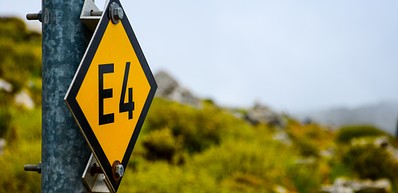
-
![Lasithi plateau, Crete]() Provided by: Anton Chygarev/Shutterstock.com
Provided by: Anton Chygarev/Shutterstock.com

Our travel guides are free to read and explore online. If you want to get your own copy, the full travel guide for this destination is available to you offline* to bring along anywhere or print for your trip.
*this will be downloaded as a PDF.Price
€4,95
Lasithi Plateau
The guide was updated:At an altitude of 850 metres, the Lasithi Plateau is the largest mountain plain in Crete. Nowadays, it has been transformed into a giant garden. There are numerous settlements at the plain where you can try local delicacies and the traditional raki drink. Lasithi plateau and its surroundings are also ideal for trekking walks or even cycling and mountain biking. A major attraction is the Dikteon cave above Psychro village, where — according to legend — the god Zeus was born and raised.
Useful Information
- Address: Lasithi Plateau, Lasithi, Crete
Digital Travel Guide Download
Our travel guides are free to read and explore online. If you want to get your own copy, the full travel guide for this destination is available to you offline* to bring along anywhere or print for your trip.
*this will be downloaded as a PDF.Price
€4,95

"The Venice of the East", Chania is characterized by a blend of Venetian, Ottoman and Neoclassical monuments and architecture. Its streets are narrow, colorful and picturesque, passing by flowered balconies, traditional knife shops, Cretan boot shops, lively restaurants and cozy cafes. Don't miss the beautiful promenade along the Venetian port, where you can see the Venetian lighthouse, one of the symbols of Chania.
Read more

Koules Fortress
The Venetian Koules Fortress, also known as Castello a Mare (which means "fort on the sea"), is one of Heraklion's main landmarks and is located on the old harbour. This big, square-shaped structure was built in the 16th century to protect the city and was subsequently armed with cannons. The rooftop offers scenic views over the sea and Heraklion city.
Read more

Historical Museum of Crete
Founded in 1953, the Historical Museum of Crete in Heraklion hosts a permanent collection showcasing the history of Crete from the third century AD to the end of the Second World War. Artefacts, paintings, sculptures, manuscripts and other objects of interest are displayed in chronological order, with visual materials, multimedia and audio guides available during your visit to help you learn more about Crete's fascinating past. A section of the museum is dedicated to the famous writer Nikos Kazantzakis. Another highlight of the exhibition are two paintings by the Greek artist El Greco: The Baptism of Christ and View of Mt. Sinai and the Monastery of St. Catherine. The museum also hosts temporary exhibitions.
Read more

Minoan Palace of Knossos
The ruins of the Palace of Knossos, the largest and most brilliant centre of the Minoan civilization, are located 5 kilometres south of the historical centre of Heraklion. Twisting corridors and stairwells, which used to connect as many as five storeys, create a truly labyrinthine complex which rivals the mythological Minoan "Labyrinth".
Read more

Heraklion Archaeological Museum
This museum is located in the center of Heraklion and is one of the most important archaeological museums in the world, thanks to its unrivalled collection of artefacts from the Bronze-age Minoan culture. The exhibits cover a period of ten millennia, from the Neolithic era until late Roman times. The introductory texts in each room explain the key features of each period, and so the evolution of culture.
Read more

Natural History Museum of Crete
The Natural History Museum of Crete does not only present the natural wealth of the island, but that of the entire Eastern Mediterranean. Here you'll find, among other things, a discovery centre for children, an earthquake simulator, aquariums and terrariums, a large collection of fossils and a replica of the largest mammal ever, which lived on Crete 9 million years ago. You'll also be able to learn about the geological evolution of Crete, about plants and organisms that thrive on the island or about extinct and endangered species. The animals are displayed by way of accurate representations in their real dimensions (dioramas). The museum features an outdoor botanical garden as well.
Read more

Elounda & Spinalonga Island
Elounda, with its luxurious villas and hotels, is the preferred escape of the rich and famous. From Elounda, you can take a 25-minute boat trip to Spinalonga Island, known for its well-preserved Venetian fortress, small pebble beaches, and for being one of Europe's last leper colonies.
Read more

Samaria Gorge
The gorge of Samaria is the longest and one of the most imposing gorges in Europe. Perhaps the most popular trekking path of Greece runs along its course, passing by varied landscapes, water springs, different types of trees, cliffs, pools and impressive rocks. The gorge is 18 kilometres long and its width varies between 150 and 3-4 metres at its narrowest point, which is known as "Sideroportes". The walk down the gorge begins at "Xiloskalo", in Omalós (at an altitude of 1,200 metres), and takes between 4 and 8 hours, depending on walking speed.
Read more

E4 European Path
Another way to explore the island of Crete is by walking and hiking. The E4 European Walking Trail section in Crete features 91 hiking routes, for a total length of 560 km, traversing diverse landscapes and rare ecosystems. If you wish to complete the entire path, you should allow 3 or 4 weeks to do so, but you can also choose the trails that appeal the most to you. For more information about the path in Crete, visit the website below.
Read more

Venetian walls of Heraklion
The fortification works of Heraklion are rightfully counted among the most important in the Eastern Mediterranean. Built in the First Byzantine period (330-840 AD), these fortifications were supplemented by the Arabs (840-961), the Byzantines (961-1204), and the Venetians (after 1211). Under threat of invasion by the Turks, a three-kilometre long wall with four gates and seven bastions was added on in 1462, and is still visible today.
Read more

Nikos Kazantzakis Museum
This museum is dedicated to the famous Cretan author Nikos Kazantzakis, who wrote "Zorba the Greek" and "The Last Temptation of Christ". Among the exhibits are his personal correspondence and diaries, souvenirs from his travels, photographs, models of theatrical sets and costumes from performances of his plays, rare audio-visual material, and works of art inspired by his books.
Read more

Lasithi Plateau
At an altitude of 850 metres, the Lasithi Plateau is the largest mountain plain in Crete. Nowadays, it has been transformed into a giant garden. There are numerous settlements at the plain where you can try local delicacies and the traditional raki drink. Lasithi plateau and its surroundings are also ideal for trekking walks or even cycling and mountain biking. A major attraction is the Dikteon cave above Psychro village, where — according to legend — the god Zeus was born and raised.
Read more

Toplou Monastery
Panagia Akrotiriani (Our Lady of the Cape) Monastery, colloquially known as Toplou Monastery, is one of Crete’s most impressive historic sights. It is a true bastion and a living museum of the island’s monastic history.
There is a small but solemn and stirring two-aisled church dedicated to the Virgin Mary and to Saint John the Theologian, decorated with murals that still survive and featuring a chancel screen with noteworthy 18th century icons.
The Ecclesiastic Art Museum houses some of Crete’s most significant icons, including Megas ei Kyrie' (Great Art Thou, Lord), a 1770 icon by Ioannis Kornaros. The icon is made up of four main sections, further separated into 57 smaller areas, and includes hundreds of faces which come together magnificently to depict the Great Blessing of Waters.
The organic vineyards on the monastery’s grounds produce organic wine of excellent quality and it is also possible to visit the winery.
Read more

Minoan Palace of Phaistos
The palace complex and the city of Phaistos were built on a hill, offering a jaw-dropping panoramic views. Sights to look out for include the Lasithi mountains in the background, and the verdant hills which surround the city.
Phaistos was the second largest Minoan city and an important administrative centre of south-central Crete. The Minoan city covered a large area around the palace complex. Mythology links Phaistos to Rhadamanthus, a brother of Minos, whose dynasty is believed to have ruled in the city. According to another story, it was founded by Phaistos, a son of Hercules. Homer mentioned that the city took part in the Trojan War, led by Idomeneus, king of Knossos and the whole of Crete.
Read more

Arkadi Monastery
Arkadi Monastery was built at the end of Venetian rule. Apart from the monks' cells, the central building also includes warehouses, stables and premises for processing agricultural products.
The two-aisled church, dedicated to Saint Constantine and Saint Helen and to the Transfiguration of the Saviour, is one of the most important architectural monuments of the Cretan Renaissance. It was completed in 1587 and its facade clearly demonstrates the penetration of western architectural trends in 16th and 17th-century Crete.
Read more

Lake Kournas
Between the cities of Chania and Rethymnon, at the north edge of the White Mountains, you can find Lake Kournas, the only freshwater lake in Crete.
Read more

Trekking in Crete
In addition to the famous Samaria gorge, there are several other beautiful gorges where you can go trekking in Crete.
The gorge of Agios Nikolaos is 4 km long and is flanked by the peaks of Ambelakia and Samari. It is considered to be the most important gorge of Psiloritis and Central Crete, and was named after the Byzantine chapel of Agios Nikolaos which is located at its southern entrance.
Zakros gorge in Eastern Crete is also called the “valley of the dead” because of the Minoan cave burials that were found there. The trekking route is 2,5 km long and begins south-east of the village of Zakros, passing through the gorge and ending next to the Minoan palace at Kato Zakros.
The gorge of Aradena is an impressive 7-kilometre long gorge. Its entrance is located at the deserted village of Aradena, at the western end of the plateau of Anopoli of Sfakia, below the imposing, high peaks of the White Mountains (Lefka Ori). Near the entrance to the gorge there is an iron Bailey bridge, which connects Anopoli with Aradena and the small settlement of Agios Ioannis to the west. It is the tallest bridge in Greece and the second tallest in Europe, therefore ideal for bungee jumping.
Rikhtis gorge is a beautiful small gorge of about 3 kilometres, located in Eastern Crete and featuring a marked route. It follows a stream that flows all year round and creates a splendid waterfall. The gorge begins a little outside the village of Exo Mouliana and ends at the beach of Rikhtis, east of Kalavros village (15 km west of Siteia).
Read more


